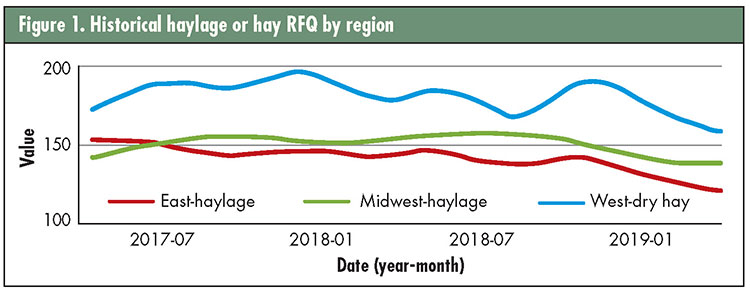Time hay cutting by ditching the calendar |
| By John Goeser |
|
|
|
Working closely with growers the past 10 years, I too often recognized that high-quality forage didn’t materialize with a traditional harvest approach. Herein, I’m defining this traditional approach as cutting hay or haylage crops on a schedule somehow connected to a calendar. For example, planning to cut hay for the first time on Memorial Day weekend or every 28 days with subsequent cuts. The calendar approach may have been more reasonable in years past when margins per hundredweight (cwt.) of milk were strong, but growers and managers need to be more aggressive and strive for improved digestible forage yield. Average simply isn’t good enough anymore, and we’re capable of producing meat and milk at lesser costs per cwt. by stepping up our forage strategies. We can get there by throwing the calendar out, scouting fields, and cutting based on plant growth stage and maturity. Have a plan Prior to getting into fields, the definition of “high quality” needs to be addressed and agreed upon with your team. In years past, your quality goal might not have been 200 RFQ, but perhaps it should be. In a prior column, “Managing the yield and quality trade-off” (Hay & Forage Grower, February 2017), we discussed balancing yield and quality. In your team meeting, run partial budgets evaluating yield differences versus nutrition and performance gains. The outcome might surprise you. In my experience, 200 RFQ alfalfa can pay back big over lesser quality (for example, 150 RFQ). Let’s recognize growers out West for showing the rest of the U.S. what’s routinely possible with RFQ. Western growers have historically cut alfalfa crops more aggressively and the result is higher quality.  To visualize this, note the RFQ trends measured at Rock River Laboratory for hay in the West (Figure 1; blue line) relative to the haylage in the Midwest and East (green and red lines, respectively) during the past two years. The West bounces up around 200 RFQ, while the red and green lines hold tight around 150 RFQ. This is an example of how management can impact quality. With a partial budget-backed goal for your farm coming out of your team meeting, the next step is to develop a plan that will make it happen. As the season approaches, accompany your crop advisers as they scout fields. Growing environment (Mother Nature) and seed genetic advances the past few years seem to have wreaked havoc on the traditional management approach. For example, in the past five years, I’ve observed buds forming on alfalfa in as little as 17 days following the prior cut date. Waiting to 28 days in that case would have resulted in heifer feed. Scouting never fails, and beyond plant maturity, it can also help us be on top of plant disease pressure, nutrient deficiencies, or other mid-season quality deterrents. Know when to go To time your cuts, follow these basic principles: For first cut, use the predictive equations for alfalfa quality (PEAQ) or growing degree days (GDD) for mostly alfalfa stands. These are research-backed tools to help forecast leaf-to-stem ratio and RFQ. Consider scissors clips of standing forage to confirm predicted RFQ as your team gets ready to cut. For second and later cuts (or alfalfa-grass or grass stands), scissors clip samples are the best option. Start by scouting fields about 15 to 20 days after the prior cut and then take scissors clippings for laboratory analysis as soon as anything that resembles a bud is apparent. Use garden shears and aim for at least three scissors clips, each from a 1-square foot area, for each field you sample. With larger fields, consider one subsample for every 10 acres in field size. Then, carefully (with gloves on), cut up all of the subsamples in a bucket into about 1-inch pieces, mix, and send a roughly 1-pound sample to your laboratory for RFQ analysis. Scissors clips are necessary because PEAQ and GDD are less sound for predicting quality with alfalfa-grass blends, grass, or for second and later cuttings. University extension groups have also historically offered reports for regional quality trends as the season unfolds. In addition to extension efforts, the crowdsourced results-sharing and free download smartphone app, FeedScan, will showcase RFQ results in your area through the harvest season. Simply download the app and click the “InField Updates” section to view RFQ results in your area for those who have sampled and shared. For both PEAQ and scissors clips, recognize that the quality measured that day is for the standing crop. Roughly 5 to 15 points of RFQ are lost through harvest (leaf loss) and fermentation losses. Thus, to capture and feed out 200 RFQ, the stand should be cut at around 215 RFQ. This article appeared in the April/May 2019 issue of Hay & Forage Grower on page 43. Not a subscriber? Click to get the print magazine. |
